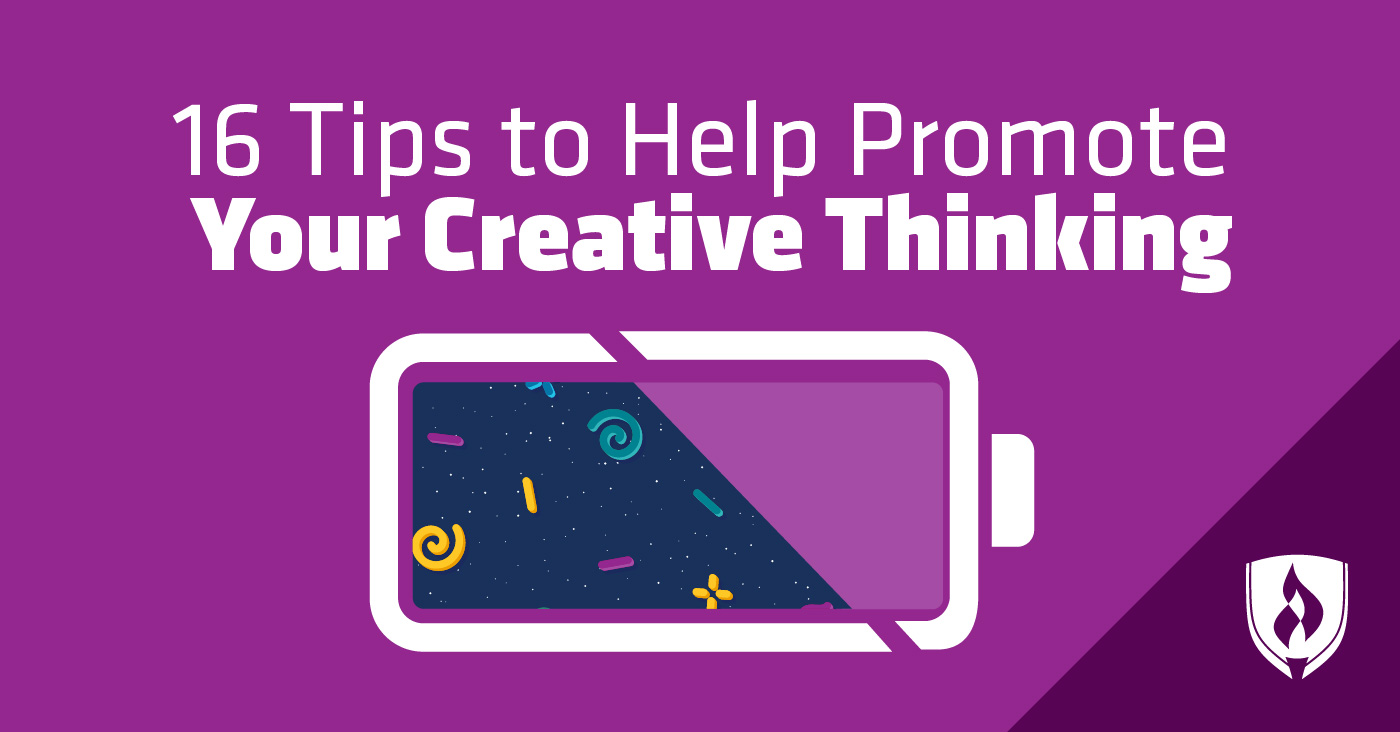
Few things are as creatively draining as a hard deadline for a work or school assignment. Musicians, writers, painters and artists of all kinds can probably recall a moment when a deadline left them staring at a blank page—feeling their creativity evaporate. When your creative ability is needed for your job, it can be hard to sustain.
But the best creatives come up with ways to nurture their creativity and keep their ideas and aesthetic fresh. “Creativity isn't magic,” says John Thatcher, owner of Artfixed. “It's a cooperation between physical parts of your brain and an interaction with new and old information.”
“Sometimes it’s difficult to be original,” says Nhu Nguyen, interactive graphic designer at Warschawski. “Whenever there’s an idea, it’s most likely already been thought of or created. The challenge is to make it your own and put more of who you are into the work.”
But how? If you find yourself facing a creative drought, or if you would prefer to implement some good creative habits before a crisis point comes, read on. These graphic designers offer up their best tips to keep your creative thinking vibrant.
16 Strategies for recharging your creative thinking ability
1. Go outside and talk to people
One of the best things to do when you are blankly staring at your screen is to just walk away and seek out other points of view. “Meet a lot of people to find your inspirations and build a network,” says Carli Shipley of YogaFit. “Always challenge yourself to burst out of your bubble once in a while and broaden your perspective.”
Shipley works from home and makes a point to get out of the house and mingle with people a few times a week. “I have found creativity can get stuck when spending a significant amount of time alone.”
While you might feel your energy refreshed just by being with people, there are other benefits to some intentional socialization. “Leave your desk, go outside, talk to potential users,” says Susie Kim, co-founder of Pluto Money. “Do an in-depth interview, show wireframes and prototypes and get a ton of feedback.” You might be surprised at the ideas a fresh pair of eyes can provide.
2. Make something hands-on
“To keep the creativity flowing, every week I make time for one small, hands-on creative project that is all about the process, not outcome,” says Larissa Pickens, owner and creative director of Float Design. “It's very freeing to step away from the computer and client work and just do something of your own.” Pickens says not to worry about how it turns out. Whether you decide to paint, build, sculpt or craft something, make it about fun and freedom.
3. Play with free software
The mindset of playing and experimenting is so good for your creativity. “I regularly experiment with new software, often available for free online,” says Sam Janzen, creative director at LUMA-iD. “When I use obscure tools and apply them to my designs I get fresh and unique work.”
4. Visit art exhibitions
Getting out of the house is already helpful, but why not double the benefit and go to a showcase of creativity? You might find yourself inspired by what artists in different genres have done. “Long days of art galleries and exhibitions are vital to my work,” Janzen says. “I'm often finding myself stealing ideas from painters and sculptors.”
5. Travel, travel, travel
While you might not have the ability to hop on a plane every time you hit a block, building travel into your life every now and then can help keep your creativity nourished. “Traveling somewhere new—whether it’s a different state or different country, there’s always so much to take in and consume culturally,” Nguyen says. “The more you can see what’s out there, more out-of-the-box ideas and creative fires are sparked.”
“Exploring other cities and countries is great for designers,” says Alexander Winston, graphic designer of PPC Protect Limited. “Not only does it expose you to different cultures and architecture, but there are also plenty of galleries and museums you can visit. It's also great to have a break every now and then that allows you to de-stress and relax.”
6. Exercise
When it comes to creativity, Thatcher points out that there is an element of science as well. “I run 20 minutes almost every morning because we know it increases blood flow to the brain.” Thatcher says there are studies that show exercise can boost brainpower and creativity. As far as quick fixes for a creative rut go, exercise might be the fastest option.
7. Browse the work of other designers
“For research and brainstorming for product design specifically, I rely on scrolling through hundreds of design inspirations,” Kim says. Kim recommends looking through sites like Dribbble, Behance, Pinterest and other graphic designers' portfolios.
8. Go for a walk
“After working for nine years as a graphic designer, I have tried absolutely everything to be able to inspire my creativity,” says Cristian Rennella, VP of design at MejorTrato.com. “However, only one tip had incredible results: Go for a walk with only one idea in your head, a pencil and a blank notebook.”
Rennella says studies support the connection between walking and creativity and that walking in the open air almost always results in a solution.
9. Get away from technology
When you’ve been scrolling the internet all day while trying to chip away at a project—you might just need a break from the screen. When you unplug a little, there’s more room for the random, creative thoughts that seem to pop up when you aren’t focusing in on anything.
“I always try to remove myself from technology for at least 30 minutes a day,” Nguyen says. “I do things like read a book, hike or take a long drive somewhere. Inspiration can come from the most unexpected places.”
For Shipley, the unplugging comes in bigger chunks. “So much of my creativity is on screens these days. So I detach myself from technology for a week and find creativity within nature. This recharges me and supports my creativity like nothing else.”
10. Read up on the business side of things
So many artists avoid the commercial aspect of their work as much as possible. But it can benefit your creativity to flex a different part of your mind. “I try and read up as much as I can on the business of graphic design,” says Eric Morris, owner of EM Graphic Design. “It helps with being able to convey important aspects to clients, who might only understand numbers.” Morris says design case studies that look at what went wrong or right with a project can also be a source of creativity and insight.
11. Make yourself an assignment
Making something from scratch with no parameters can be paralyzing, according to Brad Hines, founder and graphic designer at Ugmoo. “Sometimes I give myself a small assignment to help narrow the focus. Maybe ‘Today I will make an ugly dog sweater,’ or ‘Today I want to do a satire of a ‘90s concept.’ Then it's easier to riff prolifically within those parameters as your brain has a focus.”
While adding an assignment to your workload might feel like the last thing you need, Hines points out that making something for yourself can be revitalizing for your creativity. “So much of a graphic designer’s job is taking cues from people who don’t always have a grasp on good design. You shouldn’t feel stifled or confined in your creativeness.” Hines also points out that you can add your projects to a design portfolio, attracting clients who want the kind of work you like to do best.
12. Meditate
“I meditate and practice yoga each morning and evening,” Shipley says. “Meditation is like taking out the garbage—in order for there to be space for inspiration the old ideas must be cleared.”
Shipley says meditation helps to tune out distractions for a while and allow some mental rest, but it can also create room for bigger thoughts. “Finding a spiritual connection and opening myself up to new ideas is huge.”
13. Don’t wait on perfection
If you are meticulous with your work, it can be hard to get going. “I remind myself that a little less than perfect is better than the status quo of nothing at all,” Shipley says. “Withholding my creativity from our audience for the sake of perfectionism is selfish. It’s my ego talking.”
Shipley says it’s much better to put something out there and clean it up later, than to wait for perfection. “The imperfections are what define creativity.”
14. Seek honest feedback
“Although you might think your idea is original, a lot of the times it will look very similar to something else. This can often be a problem when you're trying to make something stand out such as a logo or icon,” Winston says. “To combat this, I regularly brainstorm ideas with the rest of our department, including the non-graphic designers. All input is welcome. Some of my best work has come from discussing likes and dislikes with colleagues.”
15. Hang onto botched material
“If I could give one piece of advice to a graduating graphic designer, it would be—never throw anything away,” Winston says. No matter how much you want to scrap something in the heat of the moment, just save it somewhere instead. Part of a good creative process involves recycling and renewing.
“The number of times I've deleted something and wished I still had a copy is unbelievable,” Winston says. “I learned that lesson the hard way—learn from my mistake.”
16. Attend a conference
“Outside of a conceptual classroom setting, more restrictions on creativity apply,” says Rachel DeFrank, graphic designer at Interprose. “In art school, you can let your creativity run wild and no idea is off limits. But most design jobs have more limitations than that.”
DeFrank says teaching your creative self to thrive under a client’s parameters involves seeing the creative challenge at play. “Your biggest challenge will be bringing those eager, creative ideas to the table while working effectively within the confines of a contract.” For this, it can be really helpful to see how other designers navigate client needs with creative exuberance.
“Attending marketing or design conferences a few times a year really helps to support my creative ambitions,” DeFrank says. “Seeing what other designers are producing always sparks spin-off ideas in my head that can be brought back to my clients.”
Ready to dive back in?
These surefire strategies for recharging your creative thinking ability are an excellent starting point for anyone pursuing a creative career—and don’t think that just means graphic design! There are several fantastic options out there for creative people. Learn more about some of the best options for you to get paid to flex your creative muscle in our article, “9 Types of Design Jobs for Creative People.”
Related Articles:
- 15 Awesome Animation Blogs You Need to Read
- How to Work with Layers in Photoshop
- Typeface vs. Font and 11 Other Typography Terms Designers Need to Know
- How to Find a Graphic Design Job: Advice from the Experts
- 6 Compelling Reasons Why Graphic Design Internships are Important
- Art vs. Design: Determining the Degree for Your Creative Career




